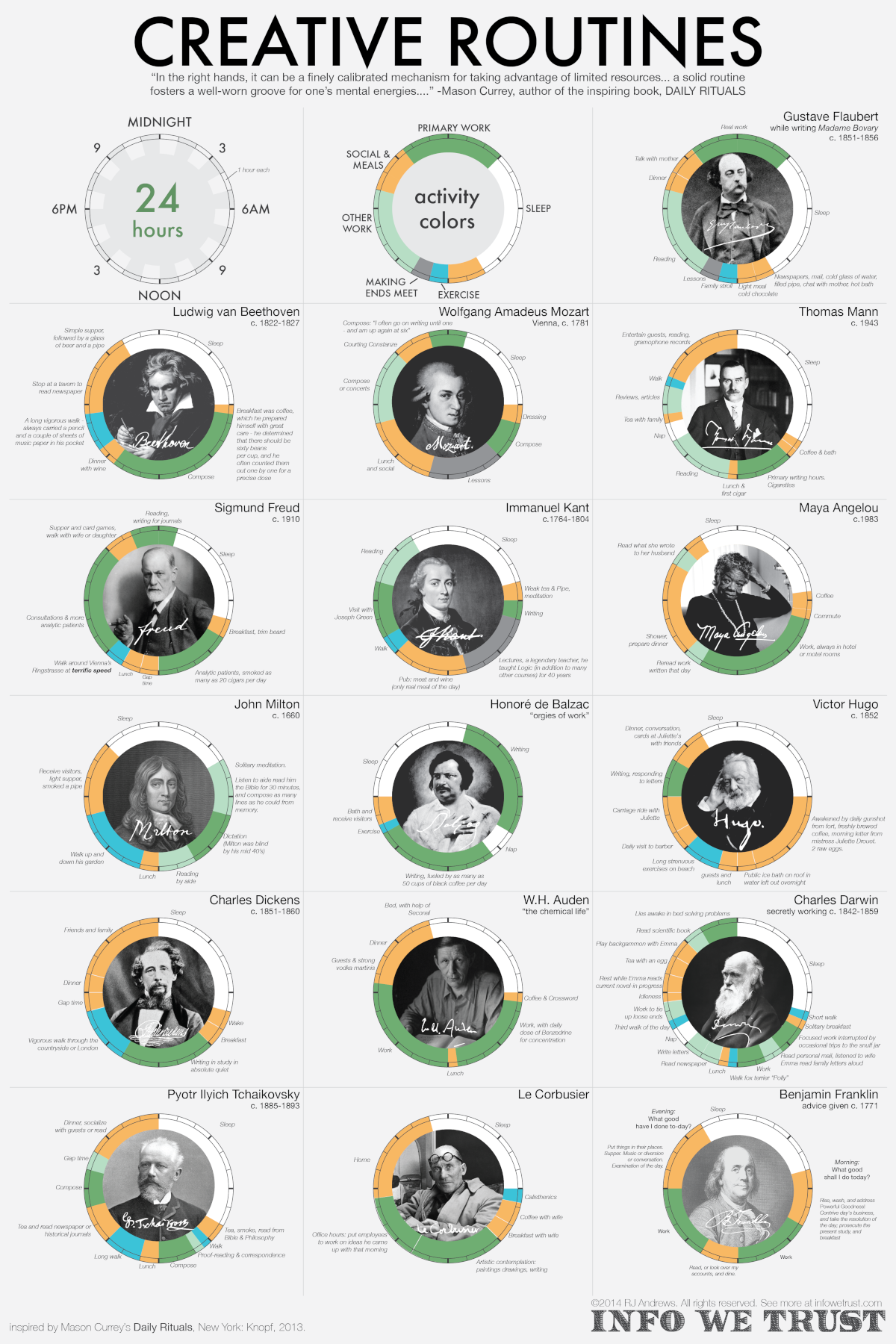
View a higher resolution version of graphic.
Visualized: The Daily Routines of Famous Creatives
What is the best daily routine to unlock creativity, or is there such a thing?
Many modern suggestions for optimizing creativity—like scheduling time for “deep work,” and building small, sustainable “atomic habits”—can be traced back to famous creatives in many different eras. And though they all found success, they employed different methods as well.
In this unique visualization, RJ Andrews from InfoWeTrust has charted how notable creatives in different fields spent their days. He picked 16 of the 161 “inspired minds” covered by Daily Rituals: How Artists Work, a book by writer and editor Mason Currey published in 2013.
How Much “Creativity Time” in Famous Daily Routines?
Dividing the day into 24 hours, Andrews denoted certain categories for daily activities like working creatively, sleeping, and other miscellaneous endeavors (meals, leisure, exercise, and social time).
For the creatives with a separate day job—Immanuel Kant and Wolfgang Amadeus Mozart—their ordinary labor is also counted in miscellaneous activities.
Below is a breakdown of the daily routine of all 16 people featured above:
| Name | Occupation | Creative (hrs) | Sleep (hrs) | Miscellaneous (hrs) |
|---|---|---|---|---|
| Maya Angelou | Writer/Poet | 9 | 7.5 | 7.5 |
| W.H. Auden | Poet | 11.5 | 7 | 5.5 |
| Honoré de Balzac | Novelist | 13.5 | 8.5 | 2 |
| L.V. Beethoven | Composer / Pianist | 8 | 8 | 8 |
| Le Corbusier | Architect | 8.5 | 7 | 8.5 |
| Charles Darwin | Naturalist / Biologist/ Geologist | 7 | 8 | 9 |
| Charles Dickens | Writer | 5 | 7 | 12 |
| Gustave Flaubert | Novelist | 10.5 | 7 | 6.5 |
| Sigmund Freud | Psychologist | 12.5 | 6 | 5.5 |
| Benjamin Franklin | Writer / Inventor / Scientist / Statesman | 8 | 7 | 9 |
| Victor Hugo | Writer | 2 | 8 | 14 |
| Immanuel Kant | Philosopher | 7 | 7 | 10 |
| Thomas Mann | Novelist | 8 | 8 | 8 |
| John Milton | Poet | 8 | 7 | 9 |
| W.A. Mozart | Composer / Pianist | 8 | 5 | 11 |
| P.I. Tchaikovsky | Composer | 4.5 | 8 | 11.5 |
The average and median amount of time spent on creative work for these individuals was just over 8 hours a day. At the extremes were two French novelists, Honoré de Balzac with 13.5 hours daily spent on creative work, and Victor Hugo with only 2 hours.
Interestingly, the allocation of creative work time was different in almost every daily routine. Maya Angelou’s routine resembles the modern work day, with the bulk of her writing between 7 a.m. to 2 p.m. Others like Kant and Mozart had creativity blocks when time allowed, such as before and after their teaching jobs.
Then there are outliers like Honoré de Balzac and Sigmund Freud, who worked as much as they could. Balzac wrote from 1:00 a.m. to 4:00 p.m. with just an hour and a half nap break in between, fueled by up to 50 cups of coffee. Freud split up his creative work into three different blocks: analyzing patients in the morning, consulting in the afternoon, and reading and writing journals into the late evening.
But somewhere in their days, most of these brilliant minds made sure to get a good rest, with an average of 7.25 hours of sleep across the board.
Schedule Yourself to Create Success
Creativity may ebb and flow, but these great minds had one clear thing in common: scheduling time for creative work.
The perfect daily routine was usually what fit in with their lifestyle (and their bodies), not based on an arbitrary amount of work. For example, night owls with later chronotypes worked late, while socialites and politicians found time outside of their commitments.
They also found time to move and enjoy life. Half of the people in the dataset specified exercise in their accounts—either leisurely strolls or fast walks. Many also scheduled social time with partners, friends, or children, often paired with a meal.
Perhaps the greatest insight, however, is that the day-to-day routine doesn’t have to look extraordinary to be able to create extraordinary work.
Much of the data is sourced from personal anecdotes by the artists themselves, or from biographers, researched and collected by Currey in Daily Rituals. In some cases, Andrews needed to assume habits — usually sleep — due to missing, or non-specific information.
The post Visualized: The Daily Routines of Famous Creatives appeared first on Visual Capitalist.